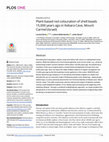Papers by Ludovic Bellot-Gurlet

PLOS ONE, 2023
Decorating the living space, objects, body and clothes with colour is a widespread human practice... more Decorating the living space, objects, body and clothes with colour is a widespread human practice. While the habitual use of red mineral pigments (such as iron-oxide, e.g., ochre) by anatomically modern humans started in Africa about 140,000 years ago, the earliest documentation of the use of organic plant or animal-based red pigments is known from only 6,000 years ago. Here, we report the oldest reliable evidence of organic red pigment use 15,000 years ago by the first sedentary hunter-gatherers in the Levant. SEM-EDS and Raman Spectroscopy analyses of 10 red-stained shell beads enabled us to detect and describe the use of a colourant made of Rubiaceae plants roots (Rubia spp., Asperula spp., Gallium spp.) to colour personal adornments from the Early Natufian of Kebara cave, Mount Carmel, Israel. This adds a previously unknown behavioural aspect of Natufian societies, namely a well-established tradition of non-dietary plant processing at the beginning of the sedentary lifestyle. Through a combined multidisciplinary approach, our study broadens the perspectives on the ornamental practices and the chaînes opé ratoires of pigmenting materials during a crucial period in human history.








Uploads
Papers by Ludovic Bellot-Gurlet